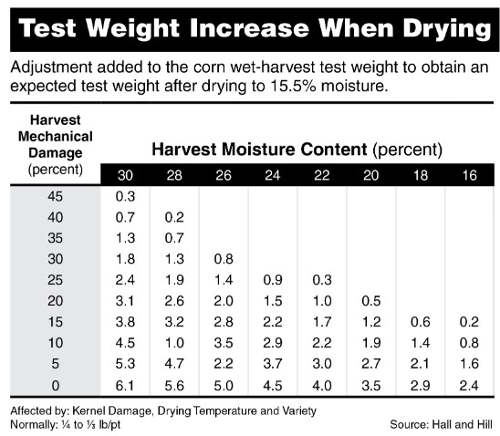Poor growing and harvesting conditions this year have North Dakota producers concerned about the test weight of their corn.
“Many factors influence the measured test weight of corn, including the physical characteristics of the kernel such as size, density, shape and surface of the kernel,” says Ken Hellevang, North Dakota State University Extension agricultural engineer.
Hybrid differences can affect test weight. As grain dries in the field or the dryer, test weight naturally increases as long as kernel integrity remains intact. Test weight increases as grain dries partly because kernel volume tends to shrink with drying, so more kernels pack into a volume bushel, and partly because drier grain is slicker, which tends to encourage kernels to pack more tightly in a volume bushel.
“Starch is heavier than moisture,” Hellevang notes. “As the moisture decreases, the kernels shrink, allowing more kernels with a higher weight to occupy a volume bushel or test weight container.”

Test Weight Increases Variable
How much the test weight increases as the corn is dried is variable. Factors such as hybrid, amount of mechanical damage during combining and “gentleness of drying” are primary factors. The test weight of corn with a high percentage of damaged kernels will increase less than corn that is hand shelled. Corn at higher moisture contents and cold temperatures likely will have more mechanical damage.
Corn dried at lower temperatures in a dryer with mixing in the dryer column generally will have a higher test weight. Grain dried at temperatures in excess of 180 degrees generally will have less increase in test weight.
“The length of time the corn is in the dryer also may impact the test weight, so corn dried from 27% to 15% moisture may have less test weight increase per point of moisture removed than corn dried from 20% to 15%,” Hellevang says. “Corn with typical harvest mechanical damage and dried gently might be expected to have a test weight increase of about 0.25 to 0.33 pound per point of moisture removed. However, corn may not have any increase in test weight under other conditions.”

Other Influencing Factors
Other factors influencing test weight include plant stresses caused by diseases, insects, soil fertility and environmental conditions. Drought stress tends to decrease the test weight because it affects the photosynthetic process. Anything that impacts the movement of nutrients to the kernel during grain fill or degrades the integrity of the kernel can affect test weight.
The planting date also can affect test weight. Early planting helps hybrid maturity and leads to higher test weight. Studies have shown that earlier-planted corn had 1 to 1.5 pounds higher test weight per bushel than corn from the same hybrids but with later plantings.
Heat and drought stress tend to decrease test weight because they affect the photosynthetic process and reduce kernel weight. Below-normal temperatures during final kernel filling impact the photosynthetic process, resulting in less than optimum starch deposition in the kernels. Higher temperatures after physiologic maturity or the black layer tend to increase the test weight if kernels are mature.
Do a search for NDSU grain drying and storage for more information.
Leaving Corn Standing